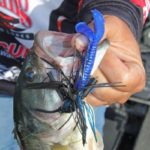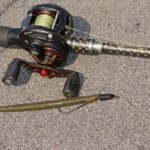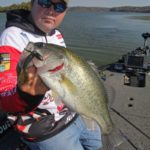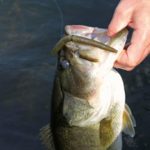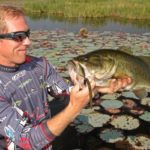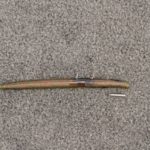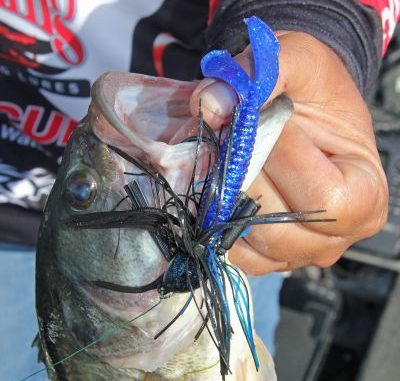
If you could take only one bait on your next bass-fishing trip, what would it be? These two touring pros share their thoughts.
No self-respecting angler would wager his entire day on a single bait. Diversity breeds opportunity, and keeping options handy fosters confidence.
Nevertheless, anglers occasionally dial in on a particular soft plastic that avails itself to multiple rigging styles and presentations.
Louisiana pro Greg Hackney has found just such a multi-tasker in Strike King’s new Rage Menace. A twin-tail grub with active craw-type arms, the bait can be rigged Texas style for flipping and pitching, added to a swimbait for an active presentation or outfitted on a football head for deeper, slower probing.
Shoot, Hack even rigs this bait on the back of a Carolina rig when he’s covering water to locate fish.
“It has a really natural swimming action,” Hackney said. “When it’s coming through the water, it looks like something alive. It doesn’t look like something flopping around behind a bait — it looks like it’s actually swimming.”
Notably, the Rage Menace comes packaged with those two tail sections connected. Hack said he breaks them loose “100 percent of the time to maximize the action.
“It fits a lot of different profiles, and it fits a big hook,” he said. “It’s a little bait that I can flip with a big weight on big line with the biggest hook (I can find).
“All around, when I want a bait with action, it fits what I want to use. It’s compact. It’s not a big, bulky bait, but it will get big bites.”
Hackney’s fellow Bassmaster Elite Series pro Kevin Hawk also finds wisdom in selecting a go-to bait. For him, it’s the 5-inch Yamamoto Senko.
The original soft-plastic stick bait created by bass legend Gary Yamamoto, the Senko’s simple form belies its multi-faceted, potential, and that’s what Hawk appreciates.
“I always have a Senko rigged on my boat; whether it’s a follow-up bait or a main presentation, it’s always on there,” Hawk said. “The cover and depth I’m fishing dictate how I have it rigged and what kind of weight I have on there.
“It’s a very versatile bait because both active and inactive fish will eat it. For example, if you’re on a crankbait bite, the fish will generally tend to be fired up and aggressive to hit one of those baits, whereas if the fish are in a neutral mode or even an inactive mode, there’s still a good chance that you’ll get bit on that bait. It gets the bites when a lot of other lure presentations don’t.”
There’s no one-size-fits-all bait, but Hackney and Hawk have figured out how to cover a wide variety of scenarios by using their preferred soft plastics in diverse configurations.
Here is a rundown of each angler’s rigging options and suggestions that’ll help you maximize your favorite bait.
Hack’s Menace Rigs
• Swim jig trailer — Using the Menace as a trailer on the Strike King Pure Poison swim jig is one of Hackney’s favorite tactics for bass and redfish around vegetation in off-colored water.
“That Pure Poison puts out a lot of vibration, and then you have that action on the tail,” he said. “It does a good job of showing the fish something other than a spinnerbait.”
• Punching rig — “The Menace has that swimming action, so I can put it on a 1 ¼- or 1 ½-ounce weight with a 6/0 Hack Attack Heavy Cover flipping hook and it’s like a little bait with a big bait profile,” Hackney said. “When I punch through that (weed mat), because it’s so slender and there’s nothing sticking out — and the way the tail hangs behind it — that bait goes through that mat so easy.
“The other deal is that as soon as it goes through, it swims down while I’m letting it free fall under the mat. And when I swim it back up, it looks like it’s trying to get out of the mat.
• Jig trailer — Hackney said he often flips a Strike King Rage Craw, but when he wants to speed up the rate of fall he goes to the streamlined Menace. With less surface area creating less drag, the Menace gets where it’s going without a lot of dillydallying.
“In the warmer months of the year — after the spawn all the way to the cold season — you want that reaction bite,” he said. “I’m not crawling that bait around the fish; I’m keeping it coming.”
• Shaky head — When clear water or finicky fish call for light-line, finesse tactics, Hackney prefers the Menace’s crawfish imitation over a finesse worm. Here, the Menace’s smaller profile allows him to fish with that finesse jig’s light wire hook on 6- to 10-pound-test line and still get a hook in the fish.
Hawk’s Senko sense
• Texas rigged — Hawk prefers this rig in shallow grass, lily pads, reeds or pad stems, and he adds a light nose weight to help escort the bait through the cover and give it the weight needed to drop into pockets where bass like to ambush prey.
He might also use this as a drop bait next to vertical cover like a dock or a tree. He’ll vary nose weights from a 1/32- to 1/16-ounce, based on wind conditions and fish depth.
• Wacky style — Impaling a Senko in a perpendicular manner (or tucking the hook under an O-ring slipped onto the worm’s body) creates an enticingly lifelike wiggle on both ends as the bait descends.
The wacky rig is a good option as soon as fish move off beds, so Hawk said he’ll use it to fish for bass suspended around docks or anytime the situation calls for a finesse look.
“There’s not a lot of action — just the quiver of the Senko that entices fish to bite,” Hawk said.
• Wacky jig — Basically a wacky presentation with a weight on the hook, this one’s good over deeper water when Hawk needs a faster presentation — maybe in a tidal fishery where he needs to get the wacky look down to the fish before the current pulls the rig out of the strike zone.
The wacky jig also offers a different look than a Texas rig for bottom presentations.
• Blinged-out Wacky — In stained water, Hawk dresses up his wacky-rigged Senko by adding an Owner Flashy Accent (size S silver Indiana blade attached to a barrel swivel with a plastic keeper the fits over the hook point and rests in the bend).
The blade’s flash and vibration help fish locate his bait while enhancing the overall appeal.
• Drop shot — Downsizing to the 3- and 4-inch Senkos offers a different look from the thin worms more common to the dropshot presentation.
A good bet anytime bass are being difficult, Hawk often bed fishes with a dropshot because it puts the bait at eye-level with the fish.
• Carolina rig — Summertime and deep water is Hawk’s top C-rig scenario. With fish mostly relating to the bottom, a subtle presentation often is what’s needed and there are few images more subtle than a c-rigged Senko.
• Neko rig — Take a wacky-rigged Senko, stick a nail weight in the head end and you have a Neko rig. Like the wacky jig, the Neko rig makes the bait fall faster, but in this case it’s a head-first descent. On the bottom, the nail weight keeps the head down for another option to the Texas rig.
